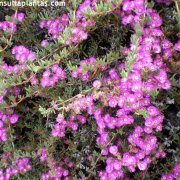Care of the succulent plant Ruschia macowanii or Beach Tentfig |
|
The genus Ruschia, family Aizoaceae, comprises 400 species of succulent plants native to South Africa. Some species are: Ruschia macowanii, Ruschia lineolata, Ruschia uncinata, Ruschia tumidula. Common names: Beach Tentfig, Sea Tentfig. They are succulent creeping plants with reddish stems that reach 20 cm (7.87") in height and 50 cm (19.68") in width. The fleshy leaves are small, triangular in section and greyish-green in color (they turn reddish in the sun). The spectacular and abundant flowering is very interesting for its long duration. The flowers are pinkish-purple in color and are up to 3 cm (1.18") in diameter. They bloom in summer and early fall. Beach Tentfig is used as cover plants in dry areas of the garden, in rockery combined with plants of the genera Sedum, Gazania, Cerastium, Drosanthemum, Lampranthus and Crassula and in pots and planters. It's ideal for gardens by the sea and for large cities because they resist pollution. Ruschia macowanii needs very sunny exposure and high temperatures. It resists occasional frosts down to -5º C (23 ºF). The soil must be well drained and can be chalky, sandy, poor or stony. Sea Tentfig is a very low-maintenance plant that needs moderate watering, waiting for the substrate to dry very well. It resists drought very well. Fertilize once in spring with mineral fertilizer for cacti and succulents. Ruschia macowanii can be attacked by fungi if there is excess moisture. Beach Tentfig is easily propagated by cuttings (they can root in a week) before or after flowering and from seeds sown in spring (it's a slower process). |
Images of the succulent plant Ruschia macowanii or Beach Tentfig |
Find plants
Ruschia macowanii or Beach Tentfig | Care and Growing
© 2026 FavThemes



